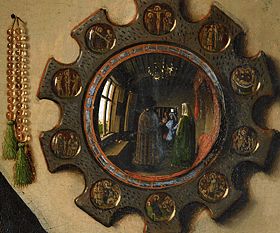 Today, we are thinking about the mirror. It’s not our fault; it’s Natalie Angier’s. Art Scatter couldn’t hold NY Times science reporter Angier in any higher regard. She manages the difficult newspaper double of 1) telling you something, often something “technical,” you don’t know and 2) explaining it in a clear and expansive way — and all in a short space! (Art Scatter could sometimes take a lesson.)
Today, we are thinking about the mirror. It’s not our fault; it’s Natalie Angier’s. Art Scatter couldn’t hold NY Times science reporter Angier in any higher regard. She manages the difficult newspaper double of 1) telling you something, often something “technical,” you don’t know and 2) explaining it in a clear and expansive way — and all in a short space! (Art Scatter could sometimes take a lesson.)
Angier’s foray into the mirror (think Alice in Wonderland) starts with Narcissus and his reflection in the pool, brushes past mirrors of antiquity, talks about some unusual medical uses of mirrors, and then gets into some surprising psychological terrain (humans behave better, it seems, when they can see themselves in a mirror), including a few paragraphs on mirrors and self image. But the shocker was straight science:
Outline your face on a mirror, and you will find it to be exactly half the size of your real face. Step back as much as you please, and the size of that outlined oval will not change: it will remain half the size of your face (or half the size of whatever part of your body you are looking at), even as the background scene reflected in the mirror steadily changes.
 Half the size? My head must be truly massive! And I thought it was rather petite all these years. Narcissus can be forgiven for falling in love with the image in the pool, then, because it is SO much more winsome than “real life,” beset as it is with Big Heads. Although Angier talks about how humans have a far higher regard for their individual beauty than the facts bear out, she doesn’t specifically address the erotics involved in the mirror. Which when you think about it, are pretty complex. There’s the possibility of watching someone furtively, by catching them unaware in a reflective surface, for example, but we begin to map a psychosexual terrain that we’ll leave for another day.
Half the size? My head must be truly massive! And I thought it was rather petite all these years. Narcissus can be forgiven for falling in love with the image in the pool, then, because it is SO much more winsome than “real life,” beset as it is with Big Heads. Although Angier talks about how humans have a far higher regard for their individual beauty than the facts bear out, she doesn’t specifically address the erotics involved in the mirror. Which when you think about it, are pretty complex. There’s the possibility of watching someone furtively, by catching them unaware in a reflective surface, for example, but we begin to map a psychosexual terrain that we’ll leave for another day.
So, how “real” is image in the mirror. Richard Rorty, if he were still with us, might suggest that the question isn’t germane because it starts to get into the metaphysics “reality.” Start describing that image, start working with it, and you start to come to some more useful judgments about it. Angier’s story suggests that the image is both a flawed representation of reality and a powerful representation of reality. I once worked in a mental health facility, the late-night shift, and I decided that one of the best things I could do to help the patients (and many of them really did need help) was to “mirror” their behavior. Not literally, of course: Just in the sense that I tried to reflect with my responses to their behavior as clearly as I could whether what they were doing fit into the range of “appropriate” or not. This was harder than it sounds, at least for me, because it took so much attention. I think we usually pass over the bulk of “normal” behavior in others. At the hospital, that was really important to reflect, not with words (“Good for you, you aren’t presently self-destructive…”) but in some other way, by action or gesture or expression. Anyway, I started calling that activity on my part mirroring, and if you had pressed me then, maybe I would have come to the same conclusion about my representation of the patients’ reality” as Angier did about the image in the mirror — flawed but powerful.
Just for fun, I’ve assembled a little gallery of famous mirror images in paintings. The first two aren’t explicitly erotic at all, though the secrets they reveal have a little edge to them. From Diego Velazquez’s Las Meninas, a famously complex painting (just read the opening chapter of Foucault’s The Order of Things), we have a detail (top): the King and Queen of Spain, the putative object of the painter (who is Velazquez), are caught in a mirror at the “back” of the painting. The detail is of that mirror; I like their self-satisfied expressions. There is also a detail (middle picture) from Jan van Eyck’s Arnolfini Portrait, a mirror that captures the backs of the subjects, among other things. It’s mainly a demonstration of painting facility, I suppose, but we search it for clues, for what’s hidden and out of frame. And finally below, Peter Paul Rubens’ Venus at a Mirror: Her head is SO big in that mirror! Natalie Angier, please explain!
